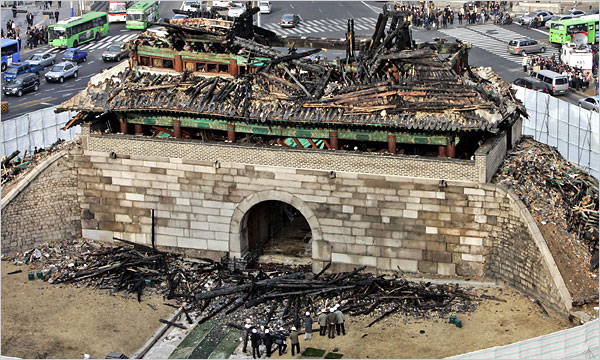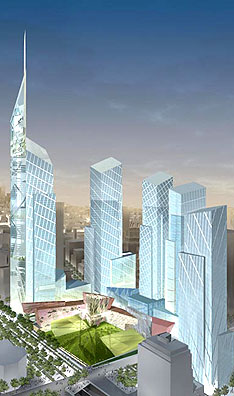 The devastation of the 600 year old gate building in Seoul, South Korea yesterday (left), has already led to plans for its reconstruction. Thoughts of rebuilding seem to have followed more swiftly than after the destruction of the World Trade Centre in New York City in 2001. Both disasters have political connotations, the WTC arguably symbolising liberal capitalism and US self-confidence, and the Great South Gate or Namdaemun in Seoul representing a national culture and historical resilience as the country and city faced various invasions over the centuries. Such moments of reconstruction alert us to the politics of architecture and how we use public space to comprehend and deal with our histories and conflicts.
The devastation of the 600 year old gate building in Seoul, South Korea yesterday (left), has already led to plans for its reconstruction. Thoughts of rebuilding seem to have followed more swiftly than after the destruction of the World Trade Centre in New York City in 2001. Both disasters have political connotations, the WTC arguably symbolising liberal capitalism and US self-confidence, and the Great South Gate or Namdaemun in Seoul representing a national culture and historical resilience as the country and city faced various invasions over the centuries. Such moments of reconstruction alert us to the politics of architecture and how we use public space to comprehend and deal with our histories and conflicts.
By coincidence, I was reading a new article yesterday by Antoine Picon at Harvard*, who argues that 9/11 forced architects to reflect on the impermanence of their creations. Instead of a building as an end point or achievement, we could think of it as a site of endless re-building, as creations are built and destroyed as if on a loop. Each episode of building and of destruction will be defined by some conflict or political tension, whether the building or space is supposed to represent national glory or peaceful public assembly, and the war, conflict or catastrophe in which it is eventually destroyed. The hopes of modernist architects to create perfect, white spaces that would imbue twentieth century publics with moderation was foolish, thinks Picon.
The plans to rebuild Seoul’s Great South Gate or new towers at NYC’s ground zero (left) as if that would end the matter would suggest the application of a sealant to history, as if a loss felt must be quickly filled in and papered over. The implication of Picon’s argument is that the new buildings should instead be designed to acknowledge and make intelligible how architecture and politics are continuous, with foundations never finished but always ahead. But when devastation is tied so closely to injured national pride, this would be a hard sell.
* Picon, A. (2008) ‘Architecture and Public Space Between Reassurance and Threat’, Journal of Architectural Education, 61:3, pp. 6-12.
